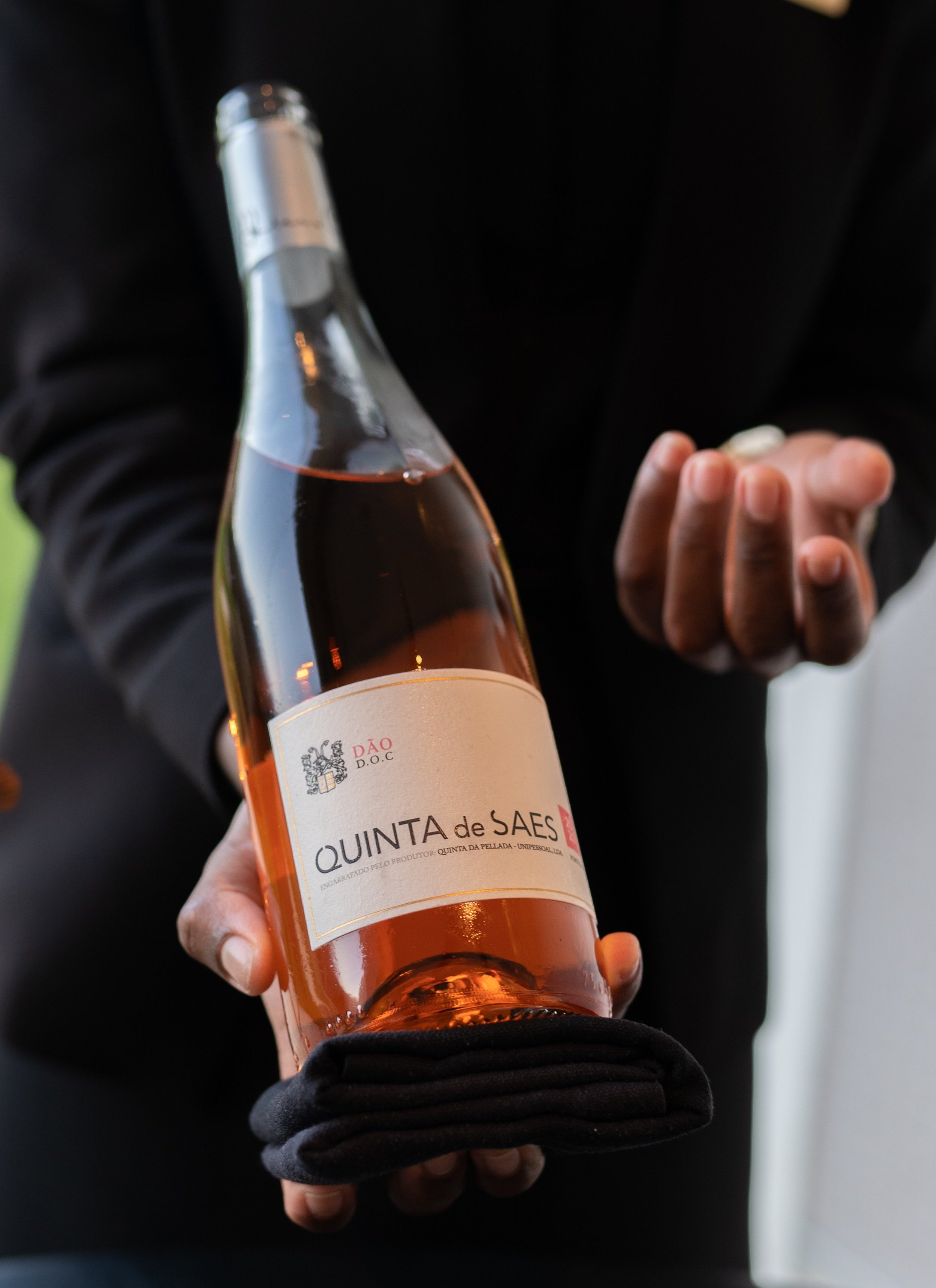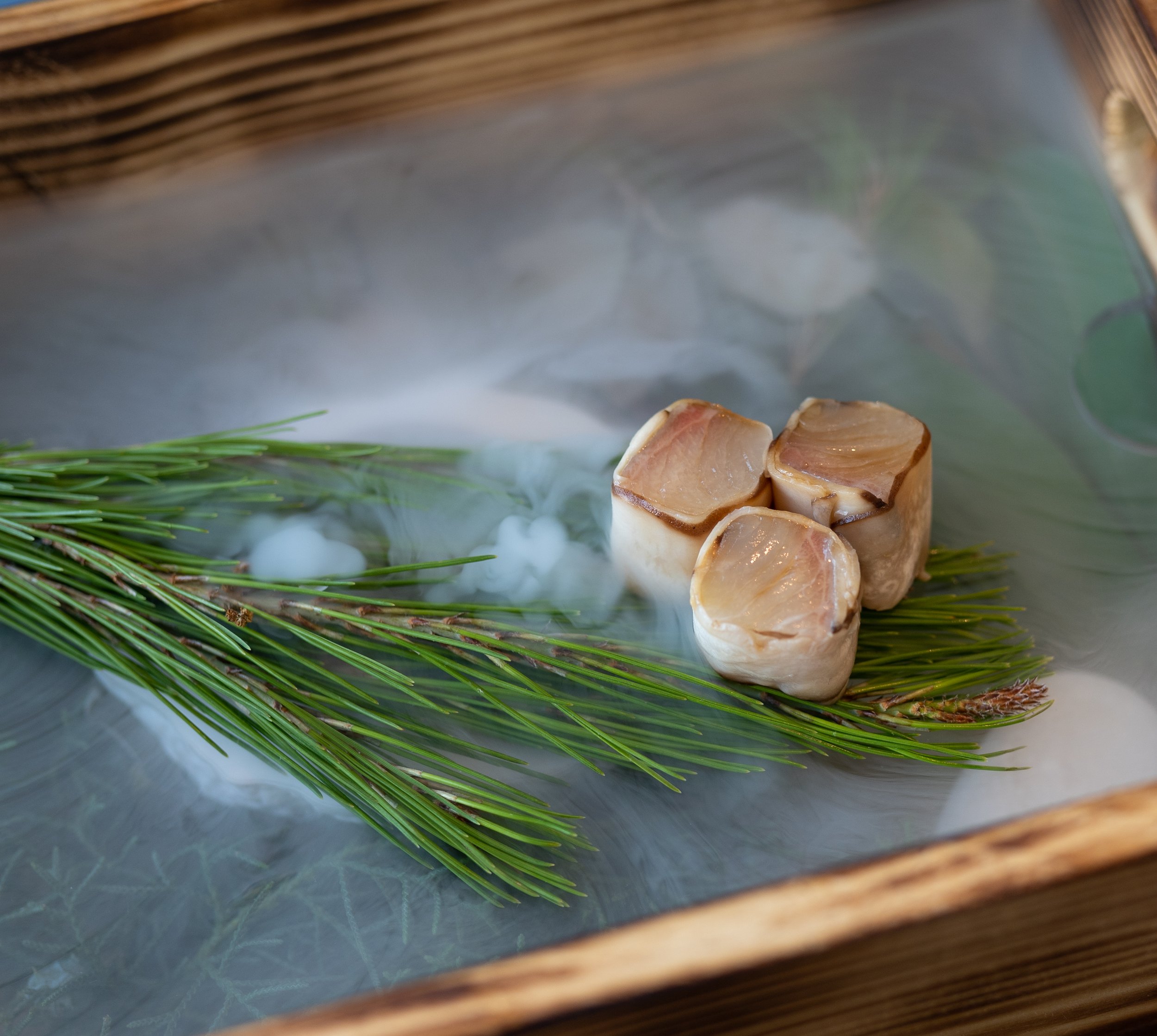Midori
Midori review at-a-glance
+Original fusion food executed with finesse and style
+Plenty of tableside theatrics made dinner feel like an experience, not just a meal
Rating: 94/100
Verdict: It’s rare for a restaurant to be original and good. The tried and true flavor combinations are just that for a reason, they work. Creativity and ambition in a tasting menu usually ends up with a few interesting dishes but also ones that make you wonder if the kitchen ever tried the food they put out. Midori was the rare restaurant where I felt like I had an original, compelling meal but the quality never dipped.
The food was deeply rooted in Chef Almeida’s Portuguese heritage despite the frequent inspiration from Japan. Perhaps this was because the story was clearly communicated by the FOH, making sure the guests appreciate what the kitchen is going for and understands how it connects to Japan, Portugal or both. Presentations were theatrical but also practical, adding to the experience and drawing your attention as you hear the story and ideas behind the dishes. The end result was a memorable meal that felt very different in the best possible way.
Price I Paid: €129 for “Menu Kiri”
Would I revisit: Yes
Date Visited: May 2022
Value: 20/20
Midori and Chef Pedro Almeida Background
Midori is a one Michelin star Portuguese and Japanese influenced restaurant tucked into the Penha Longa resort in Sintra, around 30 minutes from downtown Lisbon. The Chef at Midori is Pedro Almeida who joined in 2011, working his way up from junior sous chef to his current role. While he is Portuguese, Chef Almeida’s cooking draws heavily from a love for Japanese food garnered from his time working with sushi chef Paulo Morais. The combination of these influences resulted in a very unique brand of cooking, unlike anything I have had at other restaurants. While Japanese influences are found everywhere these days, Midori felt fresh in how it fused Japanese with Portuguese with each dish clearly showing off both cuisines but in a complementary way. I was skeptical of this brand of fusion cuisine going in but my worry was without warrant.
Nearly as important as the food being on point was the FOH making sure the thoughts and ideas of the kitchen were actually communicated to guests. Each dish was served with a detailed explanation of how it connected to Chef Almeida’s Portuguese heritage and what memories the dish was supposed to evoke. You might think this is normal but it is decidedly rare, even in the best restaurants (see multi-time Worlds50best winner Osteria Francescana). I thought this was very important, giving me an extra appreciation for the food that I would not have otherwise had.
Dinner at Midori is a tasting menu only affair with an 8 “moments” Kiri menu costing €129 while the longer 10-course Yama menu coming in at €159. These menus were even longer than the number of courses suggested with a lengthy 6 nigiri sushi course counting as one “moment”, If you wanted to indulge in the wine pairing (and you should), it costs an additional €80/€115 depending on the menu you get. Perhaps I have become too accustomed to Scandanavian prices but this seemed like an awfully good value given the amount of work evident in the very elaborate meal.
If visiting Midori, I can highly recommend an overnight stay at Penha Longa. I found the rates to be exceedingly reasonable for five-star resort (especially if you have Marriott points) a short drive from Lisbon with expansive facilities and grounds. The location is also great for exploring UNESCO world heritage site Sintra with its many castles, palaces, and unique landscape. You really can’t ask for a much better day than taking in the sites of Sintra before enjoying dinner at Midori where you can indulge fully in the wine without having to worry about driving home. Even better, make a long weekend out of it as Penha Longa actually has three different Michelin star restaurants which makes it the perfect gourmet retreat.
Speaking of wine, we did the pairing at Midori and you will want to do the same. Befitting the restaurant’s location and ethos, the wines were entirely Portuguese and showed off the diversity of styles you can find in the various terroirs of the country. Personally, I prefer this local approach to the more common globe trotting pairings as it gives a sense of place and results in more interesting choices than de rigueur Burgundies. The challenge comes in a more limited selection of of wines for the sommelier to work with but this was not a problem at Midori where the pairing matched the food beautifully.
What I ate at Midori
Like any proper meal, Midori started off with a set of nibbles served on an impressive serving board that barely fit the table. Pictured first were my favorite of the bites, toro tartar wrapped in a crispy nori sheet and an aji tataki sphere with “Spanish sauce”. Both of these really whet the appetite for what was to come, featuring great quality raw fish and strong flavors to wake up the taste buds. The nori on the tartar was particularly crisp, providing a great textural contrast to the fatty toro.
The remaining three snacks were also top shelf, consisting of fried shrimp heads with plankton and yuzu aioli, gyu katsusando with karashisumiso, and a savory pastry. It is tough to pick a favorite of these given the consistently high standard but if forced to pick, I would go with the fried shrimp heads. Served with a story of how Chef Pedro Almedia’s father was a “snack king” that cooked various bites for Pedro including frying up shrimp heads, they were deliciously crispy with plenty of shrimp flavor brightened up by the yuzu in the aioli.
While not traditional, the kitchen dressed up miso soup by serving it with ray fish, tomato, and cilantro. I really liked this, the miso packing plenty of flavor while the Portuguese roots came through nicely with the neutral ray lifted up by the herb pesto. Even better was a dish of shime saba with tomato rice which provided a pitch perfect example of the Chef’s fusion of Japanese and Portuguese. The shime saba, a classic Japanese preparation that involves curing mackerel with salt and vinegar, was high quality and would have fit in at any top Sushiya in Japan. The Portuguese influence came from the tomato rice, a common side for seafood in the country. Most importantly, the rice and fish blended together harmoniously to form a coherent and well balanced dish.
One of the more stunning presentations was a yellowtail sashimi that had been cured in eucalyptus and wrapped tightly with some impossibly thinly cut shiitake mushrooms. The theatrics came with smoke released from a table side pour of liquid from a tea kettle. While I can’t say this was the first time I have seen this type of presentation, it served a practical purpose as it added a bit of pine smell which accentuated the fish. This was followed up with arguably the most compelling dish of the night, dengaku cabbage with cod pil pil sauce. The cabbage, cut in such a way that its presentation provided a decent facsimile for cod, had great texture and blended seamlessly with the pil pil sauce which in itself was just as good as the ones I first tasted in San Sebastian.
The sushi section of the menu was served in two flights of three nigiri. Keeping with the tradition of the menu, these were not traditional edomae nigiri but instead used the well seasoned shari as a canvas to paint a fusion of Portuguese flavors. The left most bite was a roasted tomato nigiri, its appearance doing a stand in for maguro. This was a juicy bite, bursting with tomato flavor that was nicely accented by the roasting. Second, was a piece of grilled horse mackerel which had great texture and right up my alley as I love the strong taste of mackerel. Last was my favorite of the three, octopus nigiri served the traditional way and topped the “Portuguese” way with a “sucker salad”. I am not sure I would call the solitary octopus sucker placed on top of the nigiri a salad but it added a nice additional layer of texture.
The next set of nigiri was a trio of tuna working from leanest to fattiest. The leanest was lightly smoked tuna with muxama, a bottagara-like cured tuna shaved table side in ample quantity. The muxama was not quite as powerful as expected but the smoking gave the tuna a bit of complexity. Next was preserved chutoro with rosemary salt which was nicely balanced. The last nigiri was the most compelling, a binchotan seared toro with the slight aburi style charcoal grilling adding plenty of flavor and meant to evoke the smells of the Santo Antonio festival where sardines are grilled on the streets. We actually visited the Santo Antonio festival in Lisbon later in the trip and I can say the smell was pretty on point.
Apparently one of the most common meals for school children in Portugal is plain steamed hake with boiled potatoes, so much so that most Portuguese have a deep disdain for the combination by the time they reach adulthood. Rather than hide from this heritage, Chef Almedia embraced it with a main course of marbled hake with seaweed and potato in different textures. This provided a proper crescendo to the meal, a brilliant piece of fish with plenty of great technique going into the sauce and variations of potato. The presentation and flavors of the Hake reminded me a bit of one of the signature dishes at Geranium. I enjoyed the version at Midori just as much. Given Geranium just hit #1 on the 2022 Worlds 50 Best list, that is quite the compliment.
The pre-dessert when we visited Midori was a brand new creation that featured a faux peach that was filled with various forms of peach and matched with just a hint of wasabi. The intriguing inclusion of wasabi fit with the overall theme of the meal and was mercifully well judged, providing a smidge of spice and flavor that accented the peach.
If you thought adding wasabi to the pre-dessert was bold, the main dessert was even more daring as it featured seven types of seaweed, oyster flavors and yuzu. Nordic restaurants love using bizarre things like seaweed in their desserts but I find the execution rarely works as well as the staples of a classical French kitchen. This dish was the rare case where it did with pastry chef Francisco Siopa absolutely hitting it out of the park. The seaweed flavor was pronounced enough to make the flavor profile intriguing but incredibly well balanced by the yuzu. This was a delicate act but one the kitchen landed with aplomb.
Closing the dinner out was petit fours which were made to look like an inverse of the opening snacks, a clever bit of deja vu I have experienced before at Setzkasten in Düsseldorf. My favorite turned out to be the inverse of my favorite starting snack (the toro in a nori tartlet), a cannoli like shell filled with matcha custard. Overall, the sweets at Midori represented a deeply impressive showing from its pastry section - it has been some time since I have encountered such intriguing flavor choices combined with effective execution.


























